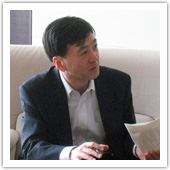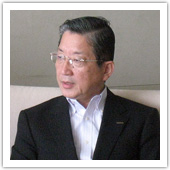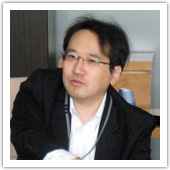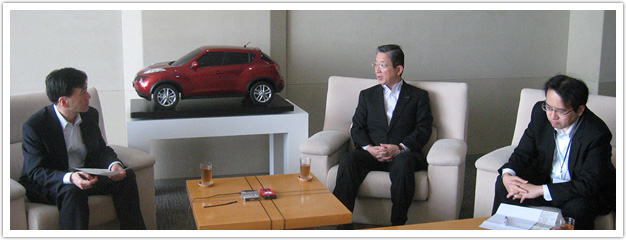 Nakajima:
Nakajima:
Restoration of the areas affected by the Great East Japan Earthquake and tsunami continues to be an urgent task that must be given the topmost priority. The devastating quake and tsunami also dealt a severe blow to Japanese industries as a whole, but particularly the automotive industry, with their nationwide production activities significantly affected by disruptions in their supply chains.
Against this background, I would like to ask JAMA Chairman Toshiyuki Shiga, who is also the chief operating officer of Nissan Motor Co., Ltd., about the damage caused by the quake and tsunami, particularly the nationwide impact of supply chain disruptions, as well as progress made with restoration work.
 Shiga:
Shiga:
To begin with, the disruption of normal operations for a period of one month due to a natural disaster constitutes unprecedented damage for Japanese plants. It is generally expected that Japanese automobile manufacturers will not be able to return to full operations before October. The reason why we cannot quickly resume full production is due to supply chain disruptions in the Tohoku region.
Suppliers in the region suffered devastating damage with their production facilities swept away by the tsunami or located in one of those areas subject to evacuation. In response, we at JAMA have embarked on industry-wide initiatives to help the affected suppliers restore operations. After consulting with the presidents of our member manufacturers, we decided that priority should be given to support in the form of manpower, given the sheer scale of damage. Thus, we set up a disaster task force within JAMA to share information across the industry.
As the disruption of supply chains has been blamed for a delay in getting production facilities fully operational, some people have suggested that Japanese manufacturers should shift from their conventional, just-in-time production system to what might be called a "just-in-case" production system in which manufacturers would maintain a certain level of inventories to be prepared "just in case." Indeed, various other options--including the geographic dispersion of production sites and the diversification of suppliers--also are being discussed.
However, I believe that no one is arguing for changing the core elements of Japan's production system. We at Nissan have no intention to do so. What I am thinking instead is that Japanese manufacturers will probably become more risk-resilient as they re-emerge from the devastating tragedy. And by achieving such a comeback ahead of other industries, I believe that those of us in the automotive industry will be able to contribute to the strengthening of the Japanese manufacturing sector as a whole.
Nakajima:
In doing so, what kinds of government support and assistance do you think might be helpful?
Shiga:
The source of Japan's manufacturing power is the individual workers on the frontline of production. Acting with a full knowledge and understanding of their respective tasks, those workers together produce excellent results, which is what I refer to as "frontline competence." Such frontline competence is not unique to the automotive industry. Indeed, it is being demonstrated throughout all the places where restoration work is underway.
Let me tell you what I have been telling those in our company. Given the scale of the disaster, we must, at any cost, pass on the strengths of Japanese manufacturing to the next generation, which I believe is our responsibility as those who were engaged in the automotive industry on March 11. This is no time for us to leave Japan or give up hope on Japanese manufacturing. We must absolutely not throw up our arms. We must overcome this disaster and make Japanese manufacturing stronger. This would be the best possible way of helping those affected by the disaster.
If I could make a request to the government, I would like to see the government help affected parts manufacturers, including small and medium-sized ones, restore their operations. None of us in the manufacturing sector is thinking about taking this opportunity to move production lines to overseas locations. Quite the contrary, through this tragic experience, we have renewed our commitment to keeping manufacturing operations in Japan.
It is too deprecating to say that it is taking months to resume production because the Japanese production system has begun to fray. Some people say that not a single car would have been rolled out if it were not in Japan. Indeed, we must regain confidence and work together with the government to create a stronger automotive industry.
What makes us feel sad is the tendency to deny the conventional manufacturing industries and/or systems in favor of creating new industries. It surely makes sense that we need to create new industries because the Japanese economy is too dependent on the automotive industry or exporting industries in general. But creating new industries by denying the automotive industry--or its manufacturing system--that has been a key growth driver for the Japanese economy should not be the way to go, because then we would not be able to take advantage of Japan's strengths.
Now, in relation to renewable energy, which is garnering increasing attention, I would like to suggest installing solar panels and/or lithium batteries in all housing units to be built or restored in the affected areas of the Tohoku region. Furthermore, we can promote the use of recyclable natural energy by utilizing electric vehicles. I strongly hope that reconstruction will proceed in such a manner.
At the moment, solar panel or lithium battery plants are operated by individual battery makers. However, in order to realize what I have just said, I think it would be a good idea if a large-scale solar panel plant was constructed in the Tohoku region under the initiative of METI and partially funded by the government. The idea is to have a conglomerate of battery makers operate the plant by bringing together the expertise and technologies they have respectively developed to date, and create jobs for local people. If solar panels were to be installed on the roofs of houses and other buildings across the country today, we would definitely need to import from China to satisfy such demand. If so, we should be able to draw up a vision for the future, in which we would build a solar panel plant somewhere in the affected region, create jobs, develop industries, and generate renewable energies.
 Nohara:
Nohara:
I perfectly agree with what Mr. Shiga has said about restoration of supply chains. Having said that, there are two points that I would like to clarify from the viewpoint of the government.
What I understand is that those manufacturers that resumed production have been able to maintain operations thanks to parts and components in stock, and that they expect to start receiving new supplies this autumn as their suppliers will be able to restore operations by then. Now, my first question is whether they will be able to continue operations until they start receiving new supplies. If they run out of stock before that, it is feared that the Japanese economy could slip into a double-dip recession. I would like to ask for your assessment of this risk.
The second question concerns the actual state of production in the automotive industry. Findings in the latest METI Survey of Production Forecast indicate that Japanese manufacturers' production is expected to have hit bottom in March and increased 3.9 percent in April, driven by the automotive industry. The ministry's Research and Statistics Department attributes this to a significant increase in the production of minicars. However, some automotive industry analysts are skeptical, questioning whether this could really be the case since microcomputers are used in such small vehicles as well. So, I wonder how Mr. Shiga finds the METI survey results, hitting the bottom in March and recovering in April. Do these findings agree with your intuitive assessment?
Shiga:
As has been announced, the stock of microcomputers will likely run out sometime in or around June. So I believe your concern is about the possibility of heading into a second dip, probably from June through August, before we return to full production in October.
However, no one in the Japanese automotive industry today would be sitting back and doing nothing while knowing that we are heading into a second dip. I would like you to presume that we are taking every possible step to prevent this from happening.
One thing I can assure you is that our people are working hard 24 hours a day to achieve something that will surprise you. In the meantime, however, our production in the United States is down by half and we will have to reduce production in China as well. All the while, our market share is being taken away by our competitors.
Another worrisome sign is that automobile manufacturers around the world are beginning to consider it unwise to continue relying on parts manufactured in Japan. Accordingly, we must do whatever it takes to help the affected parts suppliers restore operations as quickly as possible. Otherwise, these parts manufacturers could end up finding themselves without orders after rebuilding their operations at long last. In order to prevent this from happening, we are working frantically. In a recent news conference, we indicated that our restoration work would be 50 percent complete by May and 70 percent by June. But now, we are saying that it will be 80 to 90 percent complete by June.
Such is the power of Japan's automobile industry.
Nakajima:
In addition to the direct damage of the disaster, power supply constraints are posing a major threat to the Japanese economy.
Shiga:
Suppose we need to reduce power consumption by 15 percent due to the power supply shortage and we manage to achieve the same output as before despite such power constraints. This would mean an upgrading of Japan's manufacturing and greater competitiveness of Japanese manufacturers in overseas markets. We have repeated this cycle of challenge and growth over the years to become what we are today. What we need to do now is to change our mindset.
Nakajima:
Now, let me ask Mr. Nohara about the New Growth Strategy devised by METI. Various changes seen on the industrial front--brought about by the devastating earthquake--will have to be taken into consideration. What is your perspective on the implementation of measures under the New Growth Strategy in the coming months?
Nohara:
I am strongly concerned that the disaster might turn out to be the beginning of Japan's downfall. We are facing two risks that may trigger a downward spiral. One is the risk of industrial hollowing-out and the other is the risk of a fiscal crisis.
Let me talk about the second risk first. Before the March 11 earthquake, we had estimated that the existing fiscal structure of Japan--one in which 95 percent of outstanding Japanese government bonds (JGBs) are held by domestic investors--would be sustainable only for about five years. Then came the earthquake, and the Japanese government has been and will be forced to implement a range of fiscal measures. This would accelerate the ticking of Japan's fiscal time bomb by one or two years, meaning that we must pave the way for solving our fiscal problem within three years. Should we leave the fiscal problem unresolved and move into a new fiscal structure in which Japan needs to rely on overseas investors to finance its government debt, Japan would become subject to fierce market attacks similar to those to which some peripheral EU member states have experienced lately, which in turn could trigger a nonlinear decline of Japan.
The other risk is that of industrial hollowing-out. The stubbornly strong yen continues to be a burden for Japanese exporters, and a bill that would lower the effective tax rate for corporations by five percentage points has yet to be passed into law. The government has postponed its decision on possible participation in the Trans-Pacific Partnership (TPP), stepping back from its earlier claim to make such a decision by the end of June. In relation to the ongoing power supply constraints, I am extremely concerned about the possibility of a surge in the cost of electricity going forward as a result of changes in the composition of power sources, more specifically, a shift from nuclear power to fossil fuel, thermal power or natural energy sources. A rough estimation shows that a 10 percent rise in electric utility charges is approximately equivalent to a 15 percent tax hike as a burden on companies. Accordingly, allowing electricity utility charges to increase by 20 percent would be tantamount to imposing an additional 30 percent tax on companies in Japan. It is not that Japanese power utilities have put out a specific plan to raise their charges. However, I am very concerned about how these factors could serve as disincentives to discourage businesses from keeping or locating their operations in Japan.
The Japanese economy has grown and become prosperous through a trickle-down mechanism in which exporting industries earned and contributed to the national wealth, thereby benefiting those industries dependent on domestic demand. The presence of exporting industries within the country has been critically important and the automotive industry has been a leader in this respect. The competitive strength that differentiates Japan from other countries lies in its excellent manufacturing craftsmanship and technology-focused economic development. Thus, the critical question that needs to be asked is how can we maintain and enhance this unique strength, utilize it for business competitiveness, and expand other areas of strength.
Now, let me refer to some of the relevant government steps. First, in the Group of Eight (G8) summit that begins today (May 26, 2011) in France, Prime Minister Naoto Kan is to unveil the "Sunrise Plan," Japan's new energy policy calling for the development and promotion of renewable energy technologies as one of the policy pillars. Meanwhile, government advisory bodies and councils--including the government's Council on the Realization of the New Growth Strategy and the Industrial Competitiveness Committee under METI's Industrial Structural Council--are working to find ways to strengthen supply chains and iron out medium and long-term measures to restore sound power supply beyond this summer.
Nakajima:
Based on what Mr. Nohara has just discussed, I would now like to direct my question to Mr. Shiga. The Japanese automotive industry has long been faced with various risks and bottlenecks such as the strong yen, higher corporate taxes, lack of sufficient progress toward concluding free trade agreements (FTAs), stringent labor regulations, the need to implement global warming preventive measures, and power supply problems, which you have referred to as "six handicaps" for Japanese companies as quoted in media reports and elsewhere. The disruption of supply chains following the March 11 earthquake is an addition to all these hardships. Indeed, the environment surrounding the Japanese automotive industry is extremely severe. So, in light of intense competition with overseas rivals, or as you set your eyes on global operations, how are you going to take advantage of Japan's frontline competence?
Shiga:
Shiga: For the government, keeping the manufacturing function in Japan would be a matter of how to prevent the hollowing-out of industries, which includes the question of how to preserve jobs in Japan. Meanwhile, from the viewpoint of those of us in the private sector, we are determined to stay in Japan, not out of nostalgia, but because we, as global business managers, believe it is important to continue to manufacture in Japan in order to maintain our competitiveness in the global market.
Indeed, thanks to our continuous efforts to overcome the six handicaps, we have become tougher and more resilient. Visit our plant and you will see signboards with the statements, "Defeat the Strong Yen" and "Keep Domestic Production Even at 80 Yen." At each and every one of our plants, we are working out details, virtually at the millimeter level, as to what we need to do in order to beat the global competition even at 80 yen against the U.S. dollar. We have been urging the government to take measures to counter the yen's surge. At the same time, however, we have been striving to maintain manufacturing operations in Japan even at 80 yen, and such efforts have been leading to new innovations.
In short, what is important is for the public and private sectors to share the sense of crisis and to unite efforts in reconstructing the staggering Japanese economy, which is facing headwinds and becoming somewhat inward-looking. None of us in the Japanese automotive industry has given up on Japan. We still have the power to rebuild the economy and we must act now. Through this experience with the earthquake, we must show and put on record that Japan has resilience to overcome daunting difficulties as demonstrated in difficult times in the past. Toward this end, all Japanese automobile manufacturers are working frantically and at a tremendous pace to restore operations.
Nakajima:
Thank you very much for your discussion. I feel very encouraged and reassured.
Shiga:
Thank you very much.


 Nakajima:
Nakajima:
 Shiga:
Shiga:
 Nohara:
Nohara:
